University Report: Environmental Sustainability of Palm Oil Production
VerifiedAdded on 2020/05/28
|12
|2271
|120
Report
AI Summary
This report investigates the environmental sustainability of palm oil production, examining its multifaceted impacts. It begins by outlining the methodology and research questions, then delves into the challenges associated with palm oil cultivation, including deforestation, greenhouse gas emissions, and human rights violations. The report analyzes the three pillars of sustainability—environmental, economic, and social—in relation to palm oil, highlighting both its advantages and disadvantages. It then explores potential alternatives to palm oil, considering their technical feasibility, acceptability, and sustainability. The conclusion emphasizes the need for reduced palm oil plantation expansion, focusing on yield improvement, and the importance of developing a more environmentally responsible industry. The report also acknowledges the ongoing debate within the scientific community regarding the negative impacts of palm oil production and the viability of alternative solutions, such as coconut oil.
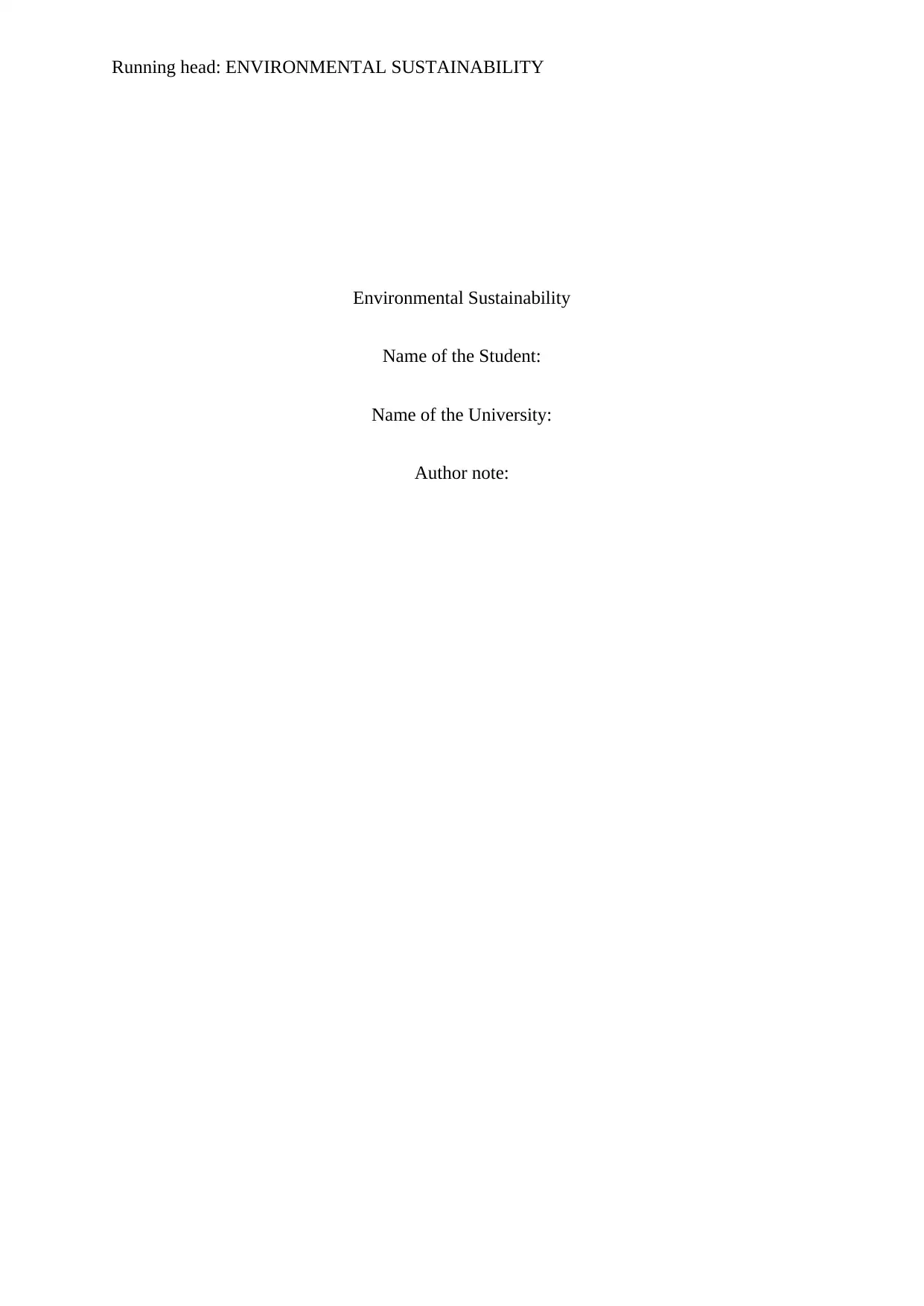
Running head: ENVIRONMENTAL SUSTAINABILITY
Environmental Sustainability
Name of the Student:
Name of the University:
Author note:
Environmental Sustainability
Name of the Student:
Name of the University:
Author note:
Paraphrase This Document
Need a fresh take? Get an instant paraphrase of this document with our AI Paraphraser
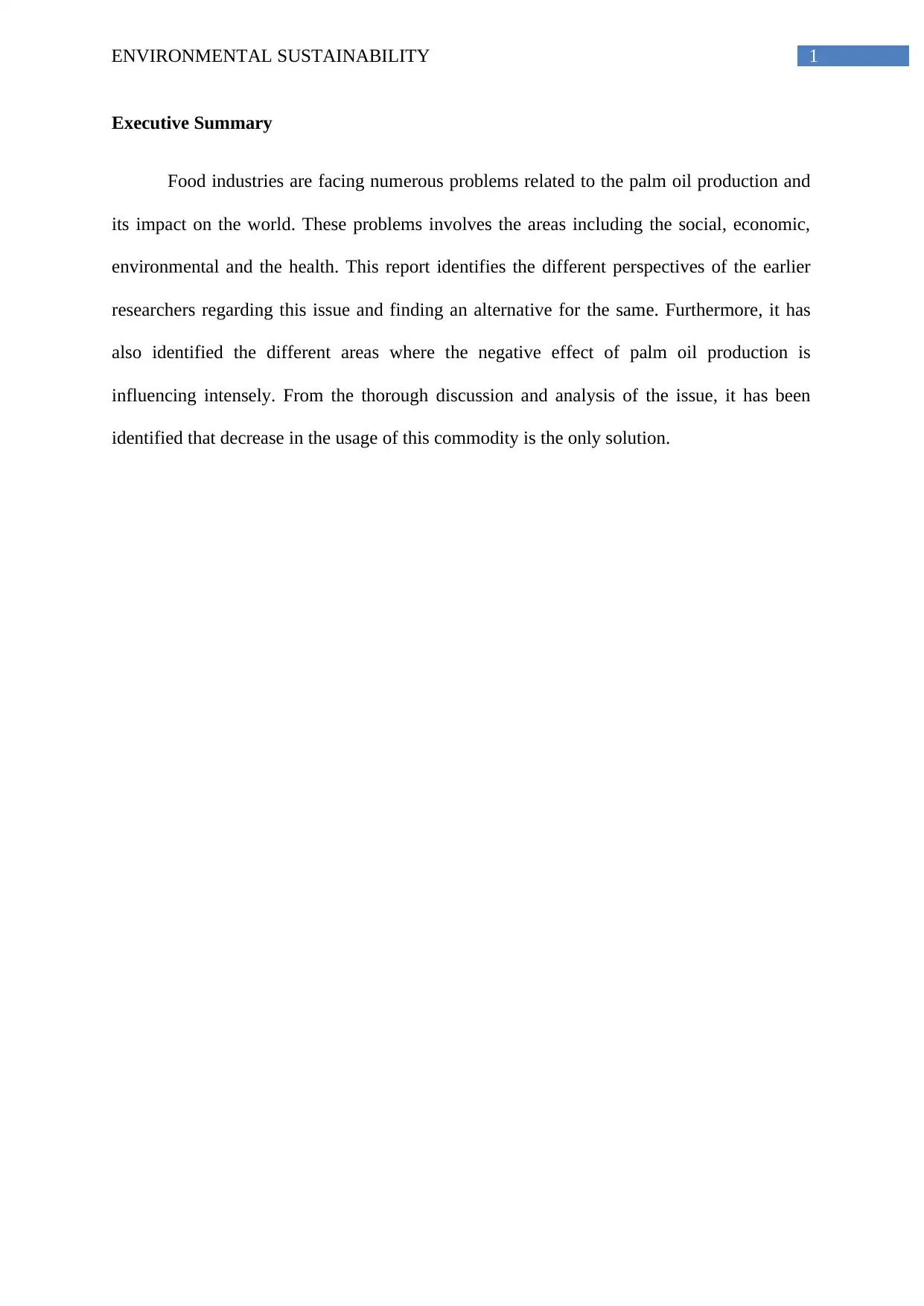
1ENVIRONMENTAL SUSTAINABILITY
Executive Summary
Food industries are facing numerous problems related to the palm oil production and
its impact on the world. These problems involves the areas including the social, economic,
environmental and the health. This report identifies the different perspectives of the earlier
researchers regarding this issue and finding an alternative for the same. Furthermore, it has
also identified the different areas where the negative effect of palm oil production is
influencing intensely. From the thorough discussion and analysis of the issue, it has been
identified that decrease in the usage of this commodity is the only solution.
Executive Summary
Food industries are facing numerous problems related to the palm oil production and
its impact on the world. These problems involves the areas including the social, economic,
environmental and the health. This report identifies the different perspectives of the earlier
researchers regarding this issue and finding an alternative for the same. Furthermore, it has
also identified the different areas where the negative effect of palm oil production is
influencing intensely. From the thorough discussion and analysis of the issue, it has been
identified that decrease in the usage of this commodity is the only solution.
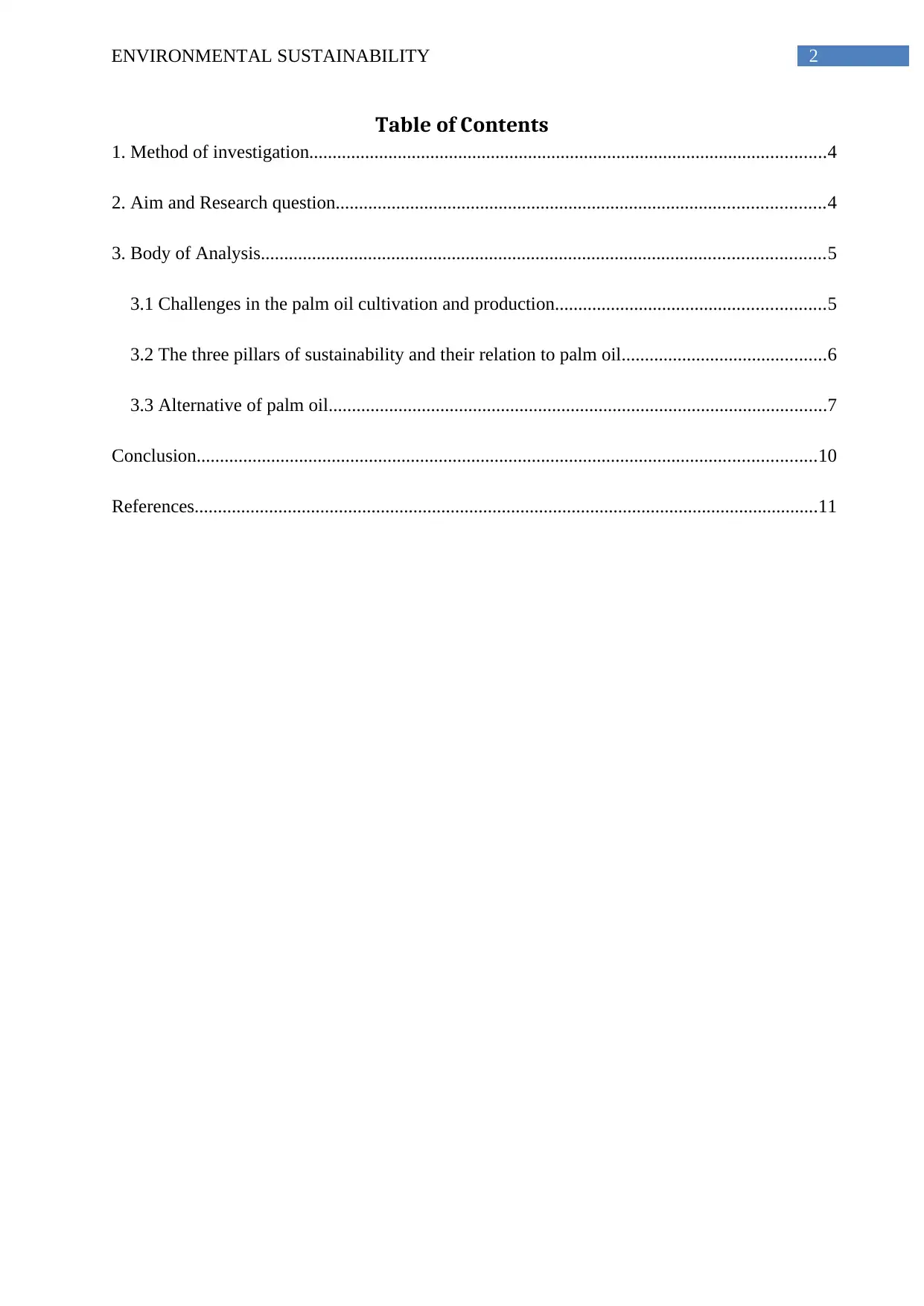
2ENVIRONMENTAL SUSTAINABILITY
Table of Contents
1. Method of investigation...............................................................................................................4
2. Aim and Research question.........................................................................................................4
3. Body of Analysis.........................................................................................................................5
3.1 Challenges in the palm oil cultivation and production..........................................................5
3.2 The three pillars of sustainability and their relation to palm oil............................................6
3.3 Alternative of palm oil...........................................................................................................7
Conclusion.....................................................................................................................................10
References......................................................................................................................................11
Table of Contents
1. Method of investigation...............................................................................................................4
2. Aim and Research question.........................................................................................................4
3. Body of Analysis.........................................................................................................................5
3.1 Challenges in the palm oil cultivation and production..........................................................5
3.2 The three pillars of sustainability and their relation to palm oil............................................6
3.3 Alternative of palm oil...........................................................................................................7
Conclusion.....................................................................................................................................10
References......................................................................................................................................11
⊘ This is a preview!⊘
Do you want full access?
Subscribe today to unlock all pages.

Trusted by 1+ million students worldwide
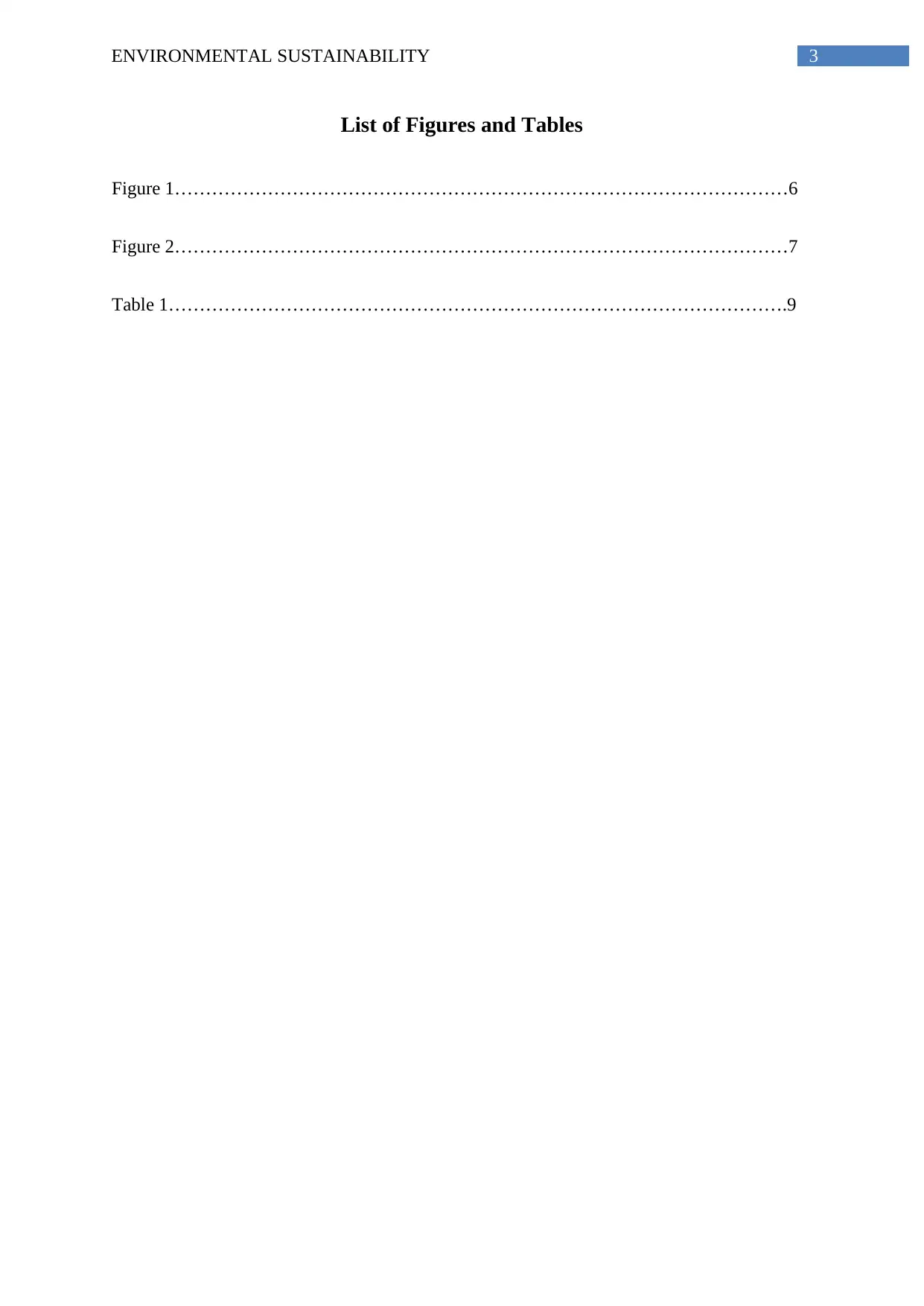
3ENVIRONMENTAL SUSTAINABILITY
List of Figures and Tables
Figure 1………………………………………………………………………………………6
Figure 2………………………………………………………………………………………7
Table 1……………………………………………………………………………………….9
List of Figures and Tables
Figure 1………………………………………………………………………………………6
Figure 2………………………………………………………………………………………7
Table 1……………………………………………………………………………………….9
Paraphrase This Document
Need a fresh take? Get an instant paraphrase of this document with our AI Paraphraser
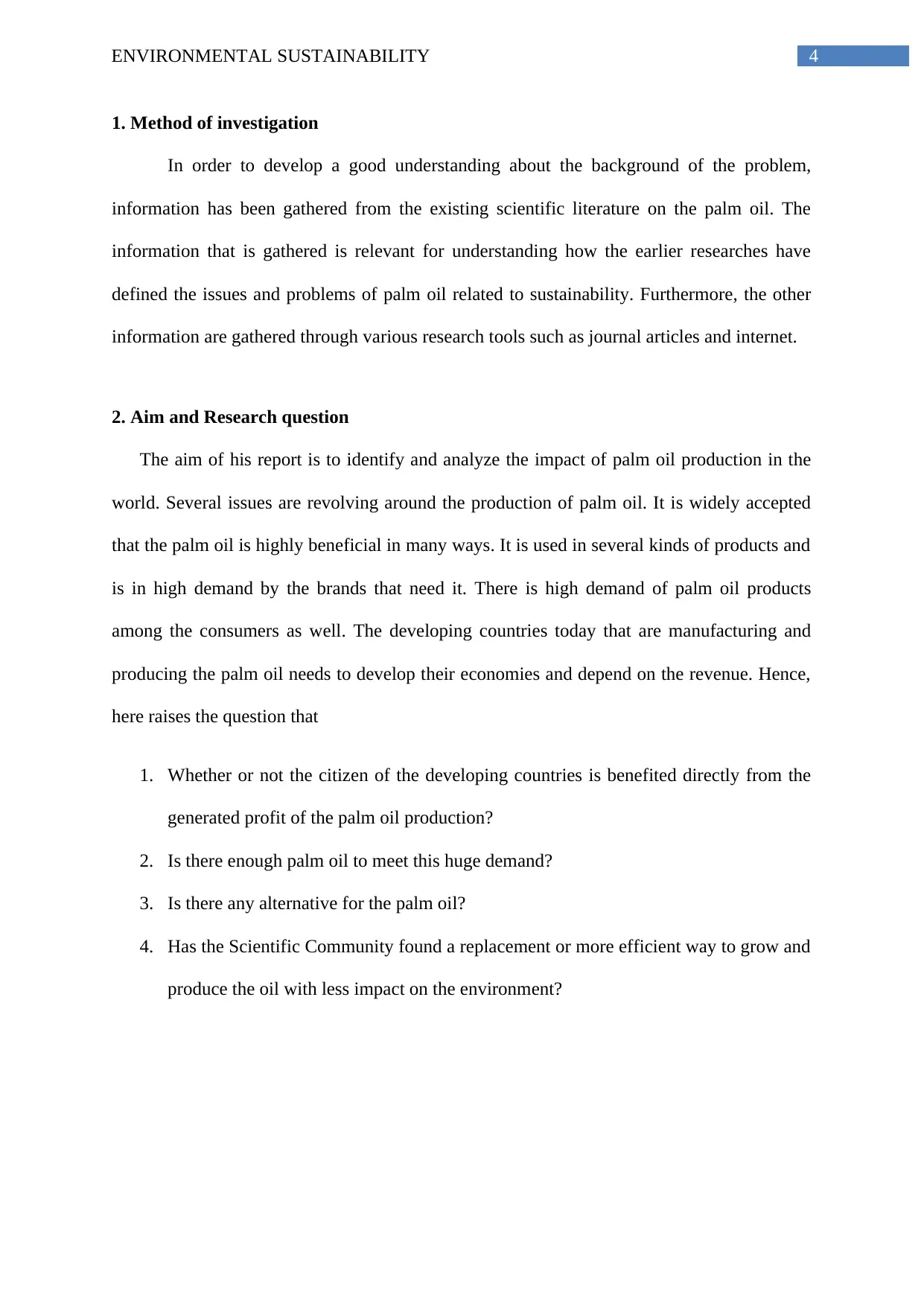
4ENVIRONMENTAL SUSTAINABILITY
1. Method of investigation
In order to develop a good understanding about the background of the problem,
information has been gathered from the existing scientific literature on the palm oil. The
information that is gathered is relevant for understanding how the earlier researches have
defined the issues and problems of palm oil related to sustainability. Furthermore, the other
information are gathered through various research tools such as journal articles and internet.
2. Aim and Research question
The aim of his report is to identify and analyze the impact of palm oil production in the
world. Several issues are revolving around the production of palm oil. It is widely accepted
that the palm oil is highly beneficial in many ways. It is used in several kinds of products and
is in high demand by the brands that need it. There is high demand of palm oil products
among the consumers as well. The developing countries today that are manufacturing and
producing the palm oil needs to develop their economies and depend on the revenue. Hence,
here raises the question that
1. Whether or not the citizen of the developing countries is benefited directly from the
generated profit of the palm oil production?
2. Is there enough palm oil to meet this huge demand?
3. Is there any alternative for the palm oil?
4. Has the Scientific Community found a replacement or more efficient way to grow and
produce the oil with less impact on the environment?
1. Method of investigation
In order to develop a good understanding about the background of the problem,
information has been gathered from the existing scientific literature on the palm oil. The
information that is gathered is relevant for understanding how the earlier researches have
defined the issues and problems of palm oil related to sustainability. Furthermore, the other
information are gathered through various research tools such as journal articles and internet.
2. Aim and Research question
The aim of his report is to identify and analyze the impact of palm oil production in the
world. Several issues are revolving around the production of palm oil. It is widely accepted
that the palm oil is highly beneficial in many ways. It is used in several kinds of products and
is in high demand by the brands that need it. There is high demand of palm oil products
among the consumers as well. The developing countries today that are manufacturing and
producing the palm oil needs to develop their economies and depend on the revenue. Hence,
here raises the question that
1. Whether or not the citizen of the developing countries is benefited directly from the
generated profit of the palm oil production?
2. Is there enough palm oil to meet this huge demand?
3. Is there any alternative for the palm oil?
4. Has the Scientific Community found a replacement or more efficient way to grow and
produce the oil with less impact on the environment?
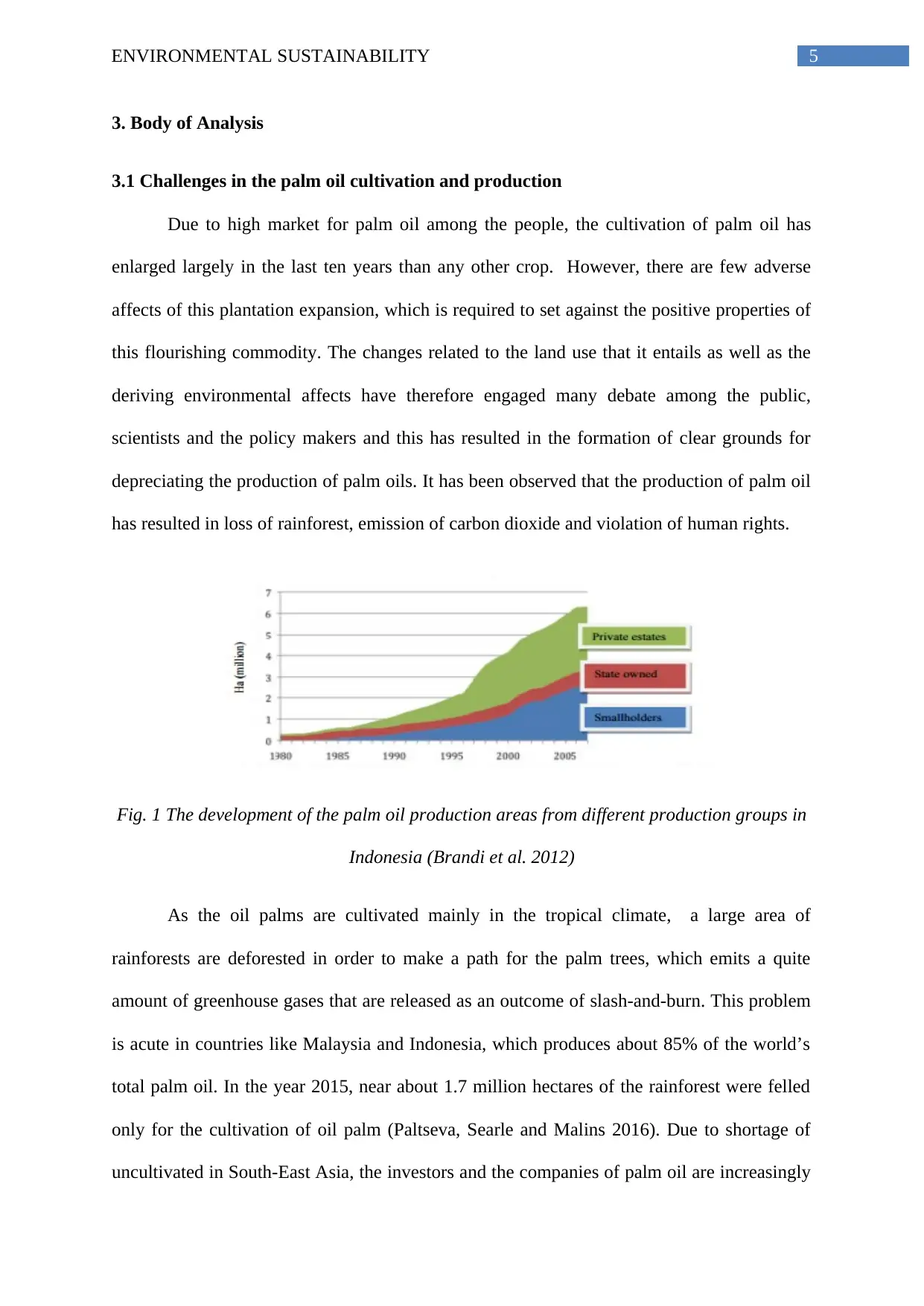
5ENVIRONMENTAL SUSTAINABILITY
3. Body of Analysis
3.1 Challenges in the palm oil cultivation and production
Due to high market for palm oil among the people, the cultivation of palm oil has
enlarged largely in the last ten years than any other crop. However, there are few adverse
affects of this plantation expansion, which is required to set against the positive properties of
this flourishing commodity. The changes related to the land use that it entails as well as the
deriving environmental affects have therefore engaged many debate among the public,
scientists and the policy makers and this has resulted in the formation of clear grounds for
depreciating the production of palm oils. It has been observed that the production of palm oil
has resulted in loss of rainforest, emission of carbon dioxide and violation of human rights.
Fig. 1 The development of the palm oil production areas from different production groups in
Indonesia (Brandi et al. 2012)
As the oil palms are cultivated mainly in the tropical climate, a large area of
rainforests are deforested in order to make a path for the palm trees, which emits a quite
amount of greenhouse gases that are released as an outcome of slash-and-burn. This problem
is acute in countries like Malaysia and Indonesia, which produces about 85% of the world’s
total palm oil. In the year 2015, near about 1.7 million hectares of the rainforest were felled
only for the cultivation of oil palm (Paltseva, Searle and Malins 2016). Due to shortage of
uncultivated in South-East Asia, the investors and the companies of palm oil are increasingly
3. Body of Analysis
3.1 Challenges in the palm oil cultivation and production
Due to high market for palm oil among the people, the cultivation of palm oil has
enlarged largely in the last ten years than any other crop. However, there are few adverse
affects of this plantation expansion, which is required to set against the positive properties of
this flourishing commodity. The changes related to the land use that it entails as well as the
deriving environmental affects have therefore engaged many debate among the public,
scientists and the policy makers and this has resulted in the formation of clear grounds for
depreciating the production of palm oils. It has been observed that the production of palm oil
has resulted in loss of rainforest, emission of carbon dioxide and violation of human rights.
Fig. 1 The development of the palm oil production areas from different production groups in
Indonesia (Brandi et al. 2012)
As the oil palms are cultivated mainly in the tropical climate, a large area of
rainforests are deforested in order to make a path for the palm trees, which emits a quite
amount of greenhouse gases that are released as an outcome of slash-and-burn. This problem
is acute in countries like Malaysia and Indonesia, which produces about 85% of the world’s
total palm oil. In the year 2015, near about 1.7 million hectares of the rainforest were felled
only for the cultivation of oil palm (Paltseva, Searle and Malins 2016). Due to shortage of
uncultivated in South-East Asia, the investors and the companies of palm oil are increasingly
⊘ This is a preview!⊘
Do you want full access?
Subscribe today to unlock all pages.

Trusted by 1+ million students worldwide
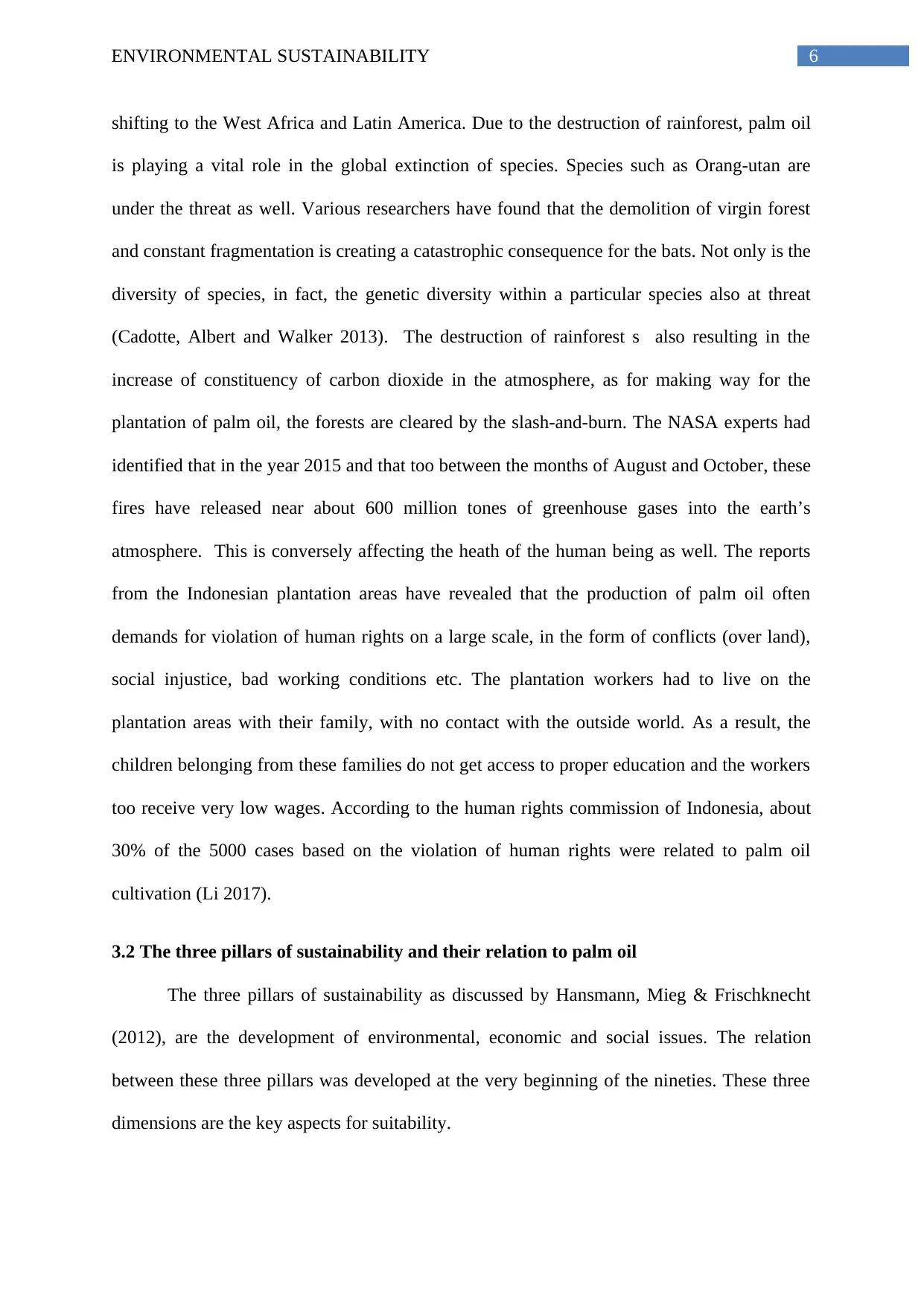
6ENVIRONMENTAL SUSTAINABILITY
shifting to the West Africa and Latin America. Due to the destruction of rainforest, palm oil
is playing a vital role in the global extinction of species. Species such as Orang-utan are
under the threat as well. Various researchers have found that the demolition of virgin forest
and constant fragmentation is creating a catastrophic consequence for the bats. Not only is the
diversity of species, in fact, the genetic diversity within a particular species also at threat
(Cadotte, Albert and Walker 2013). The destruction of rainforest s also resulting in the
increase of constituency of carbon dioxide in the atmosphere, as for making way for the
plantation of palm oil, the forests are cleared by the slash-and-burn. The NASA experts had
identified that in the year 2015 and that too between the months of August and October, these
fires have released near about 600 million tones of greenhouse gases into the earth’s
atmosphere. This is conversely affecting the heath of the human being as well. The reports
from the Indonesian plantation areas have revealed that the production of palm oil often
demands for violation of human rights on a large scale, in the form of conflicts (over land),
social injustice, bad working conditions etc. The plantation workers had to live on the
plantation areas with their family, with no contact with the outside world. As a result, the
children belonging from these families do not get access to proper education and the workers
too receive very low wages. According to the human rights commission of Indonesia, about
30% of the 5000 cases based on the violation of human rights were related to palm oil
cultivation (Li 2017).
3.2 The three pillars of sustainability and their relation to palm oil
The three pillars of sustainability as discussed by Hansmann, Mieg & Frischknecht
(2012), are the development of environmental, economic and social issues. The relation
between these three pillars was developed at the very beginning of the nineties. These three
dimensions are the key aspects for suitability.
shifting to the West Africa and Latin America. Due to the destruction of rainforest, palm oil
is playing a vital role in the global extinction of species. Species such as Orang-utan are
under the threat as well. Various researchers have found that the demolition of virgin forest
and constant fragmentation is creating a catastrophic consequence for the bats. Not only is the
diversity of species, in fact, the genetic diversity within a particular species also at threat
(Cadotte, Albert and Walker 2013). The destruction of rainforest s also resulting in the
increase of constituency of carbon dioxide in the atmosphere, as for making way for the
plantation of palm oil, the forests are cleared by the slash-and-burn. The NASA experts had
identified that in the year 2015 and that too between the months of August and October, these
fires have released near about 600 million tones of greenhouse gases into the earth’s
atmosphere. This is conversely affecting the heath of the human being as well. The reports
from the Indonesian plantation areas have revealed that the production of palm oil often
demands for violation of human rights on a large scale, in the form of conflicts (over land),
social injustice, bad working conditions etc. The plantation workers had to live on the
plantation areas with their family, with no contact with the outside world. As a result, the
children belonging from these families do not get access to proper education and the workers
too receive very low wages. According to the human rights commission of Indonesia, about
30% of the 5000 cases based on the violation of human rights were related to palm oil
cultivation (Li 2017).
3.2 The three pillars of sustainability and their relation to palm oil
The three pillars of sustainability as discussed by Hansmann, Mieg & Frischknecht
(2012), are the development of environmental, economic and social issues. The relation
between these three pillars was developed at the very beginning of the nineties. These three
dimensions are the key aspects for suitability.
Paraphrase This Document
Need a fresh take? Get an instant paraphrase of this document with our AI Paraphraser
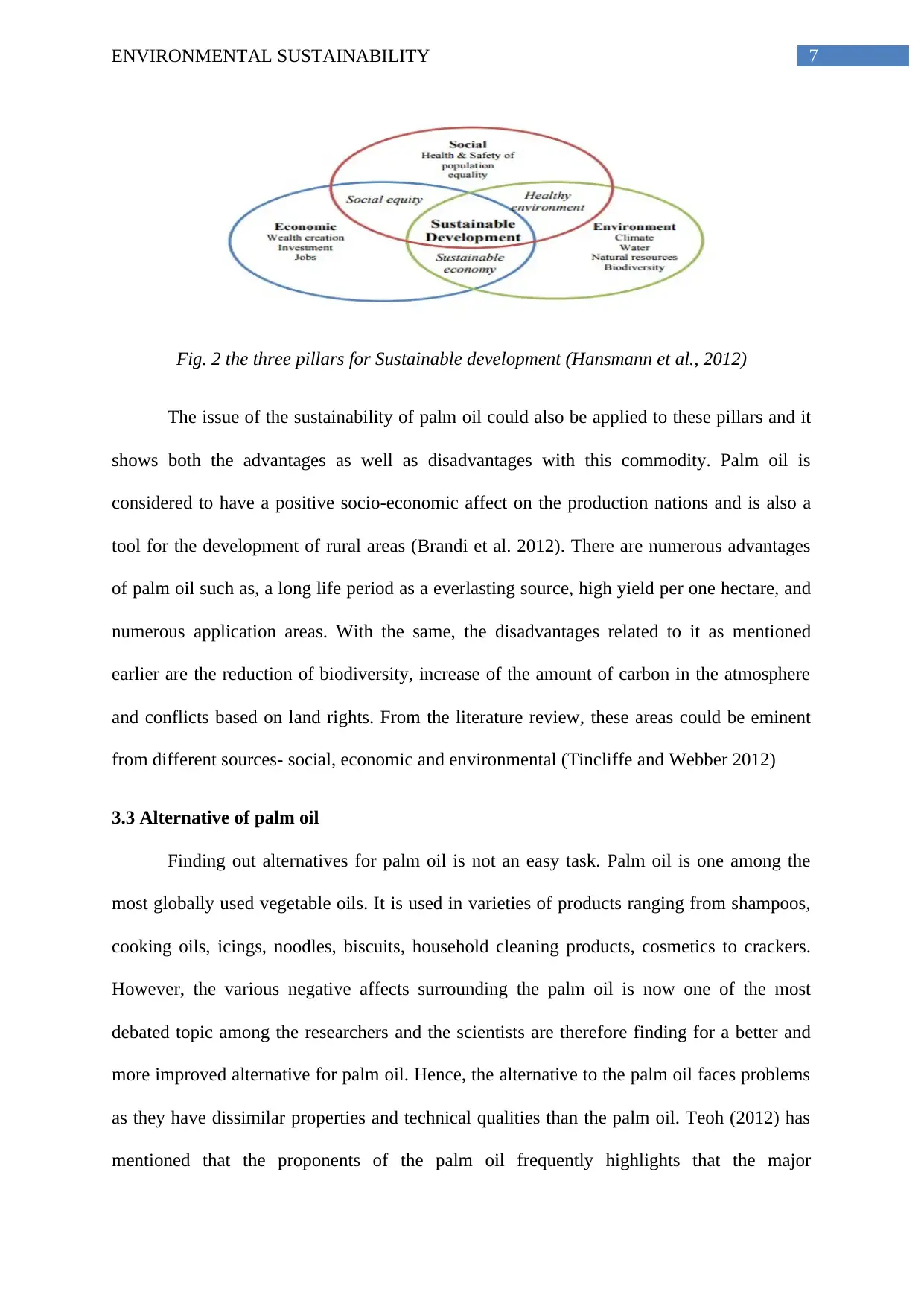
7ENVIRONMENTAL SUSTAINABILITY
Fig. 2 the three pillars for Sustainable development (Hansmann et al., 2012)
The issue of the sustainability of palm oil could also be applied to these pillars and it
shows both the advantages as well as disadvantages with this commodity. Palm oil is
considered to have a positive socio-economic affect on the production nations and is also a
tool for the development of rural areas (Brandi et al. 2012). There are numerous advantages
of palm oil such as, a long life period as a everlasting source, high yield per one hectare, and
numerous application areas. With the same, the disadvantages related to it as mentioned
earlier are the reduction of biodiversity, increase of the amount of carbon in the atmosphere
and conflicts based on land rights. From the literature review, these areas could be eminent
from different sources- social, economic and environmental (Tincliffe and Webber 2012)
3.3 Alternative of palm oil
Finding out alternatives for palm oil is not an easy task. Palm oil is one among the
most globally used vegetable oils. It is used in varieties of products ranging from shampoos,
cooking oils, icings, noodles, biscuits, household cleaning products, cosmetics to crackers.
However, the various negative affects surrounding the palm oil is now one of the most
debated topic among the researchers and the scientists are therefore finding for a better and
more improved alternative for palm oil. Hence, the alternative to the palm oil faces problems
as they have dissimilar properties and technical qualities than the palm oil. Teoh (2012) has
mentioned that the proponents of the palm oil frequently highlights that the major
Fig. 2 the three pillars for Sustainable development (Hansmann et al., 2012)
The issue of the sustainability of palm oil could also be applied to these pillars and it
shows both the advantages as well as disadvantages with this commodity. Palm oil is
considered to have a positive socio-economic affect on the production nations and is also a
tool for the development of rural areas (Brandi et al. 2012). There are numerous advantages
of palm oil such as, a long life period as a everlasting source, high yield per one hectare, and
numerous application areas. With the same, the disadvantages related to it as mentioned
earlier are the reduction of biodiversity, increase of the amount of carbon in the atmosphere
and conflicts based on land rights. From the literature review, these areas could be eminent
from different sources- social, economic and environmental (Tincliffe and Webber 2012)
3.3 Alternative of palm oil
Finding out alternatives for palm oil is not an easy task. Palm oil is one among the
most globally used vegetable oils. It is used in varieties of products ranging from shampoos,
cooking oils, icings, noodles, biscuits, household cleaning products, cosmetics to crackers.
However, the various negative affects surrounding the palm oil is now one of the most
debated topic among the researchers and the scientists are therefore finding for a better and
more improved alternative for palm oil. Hence, the alternative to the palm oil faces problems
as they have dissimilar properties and technical qualities than the palm oil. Teoh (2012) has
mentioned that the proponents of the palm oil frequently highlights that the major
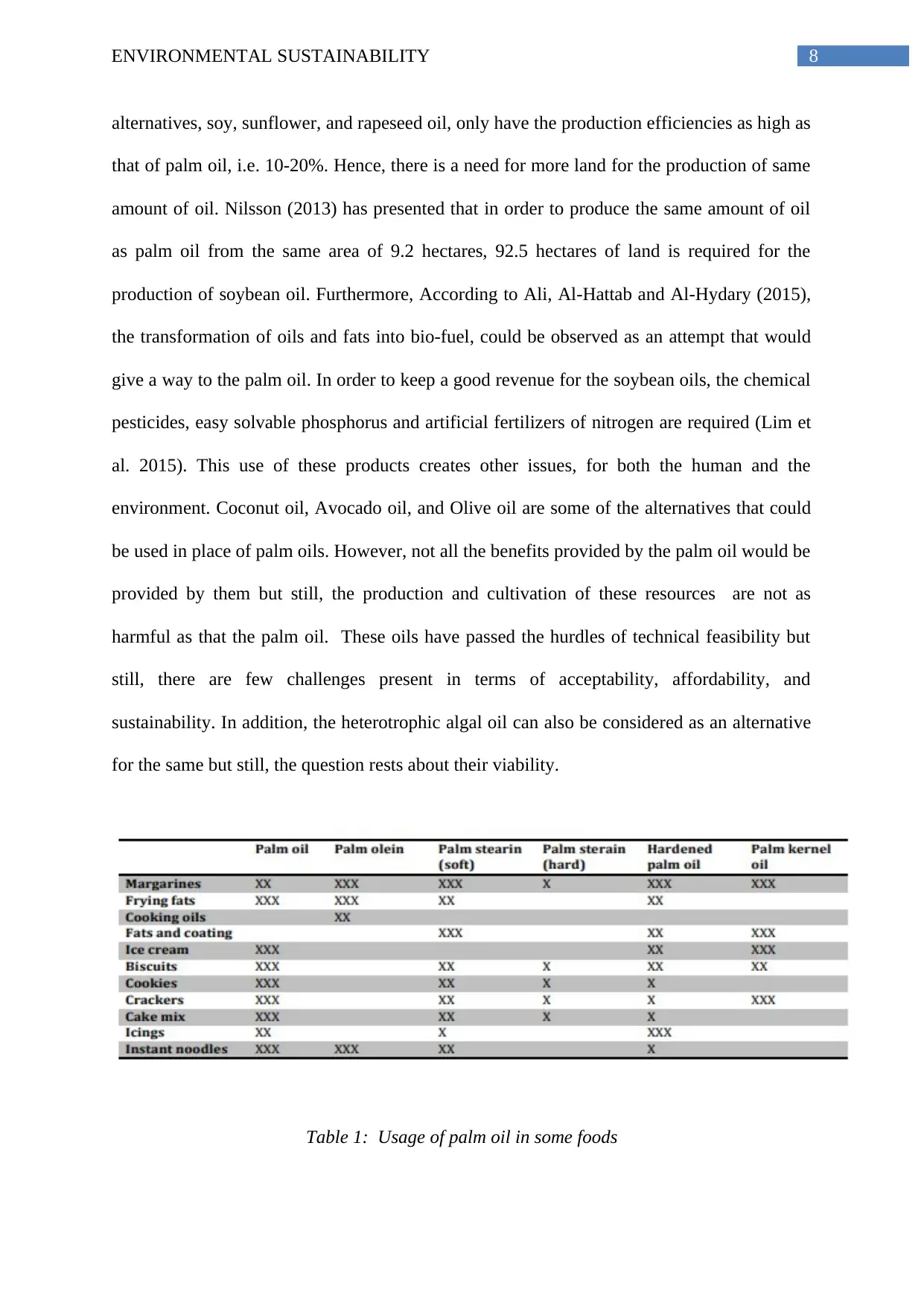
8ENVIRONMENTAL SUSTAINABILITY
alternatives, soy, sunflower, and rapeseed oil, only have the production efficiencies as high as
that of palm oil, i.e. 10-20%. Hence, there is a need for more land for the production of same
amount of oil. Nilsson (2013) has presented that in order to produce the same amount of oil
as palm oil from the same area of 9.2 hectares, 92.5 hectares of land is required for the
production of soybean oil. Furthermore, According to Ali, Al-Hattab and Al-Hydary (2015),
the transformation of oils and fats into bio-fuel, could be observed as an attempt that would
give a way to the palm oil. In order to keep a good revenue for the soybean oils, the chemical
pesticides, easy solvable phosphorus and artificial fertilizers of nitrogen are required (Lim et
al. 2015). This use of these products creates other issues, for both the human and the
environment. Coconut oil, Avocado oil, and Olive oil are some of the alternatives that could
be used in place of palm oils. However, not all the benefits provided by the palm oil would be
provided by them but still, the production and cultivation of these resources are not as
harmful as that the palm oil. These oils have passed the hurdles of technical feasibility but
still, there are few challenges present in terms of acceptability, affordability, and
sustainability. In addition, the heterotrophic algal oil can also be considered as an alternative
for the same but still, the question rests about their viability.
Table 1: Usage of palm oil in some foods
alternatives, soy, sunflower, and rapeseed oil, only have the production efficiencies as high as
that of palm oil, i.e. 10-20%. Hence, there is a need for more land for the production of same
amount of oil. Nilsson (2013) has presented that in order to produce the same amount of oil
as palm oil from the same area of 9.2 hectares, 92.5 hectares of land is required for the
production of soybean oil. Furthermore, According to Ali, Al-Hattab and Al-Hydary (2015),
the transformation of oils and fats into bio-fuel, could be observed as an attempt that would
give a way to the palm oil. In order to keep a good revenue for the soybean oils, the chemical
pesticides, easy solvable phosphorus and artificial fertilizers of nitrogen are required (Lim et
al. 2015). This use of these products creates other issues, for both the human and the
environment. Coconut oil, Avocado oil, and Olive oil are some of the alternatives that could
be used in place of palm oils. However, not all the benefits provided by the palm oil would be
provided by them but still, the production and cultivation of these resources are not as
harmful as that the palm oil. These oils have passed the hurdles of technical feasibility but
still, there are few challenges present in terms of acceptability, affordability, and
sustainability. In addition, the heterotrophic algal oil can also be considered as an alternative
for the same but still, the question rests about their viability.
Table 1: Usage of palm oil in some foods
⊘ This is a preview!⊘
Do you want full access?
Subscribe today to unlock all pages.

Trusted by 1+ million students worldwide
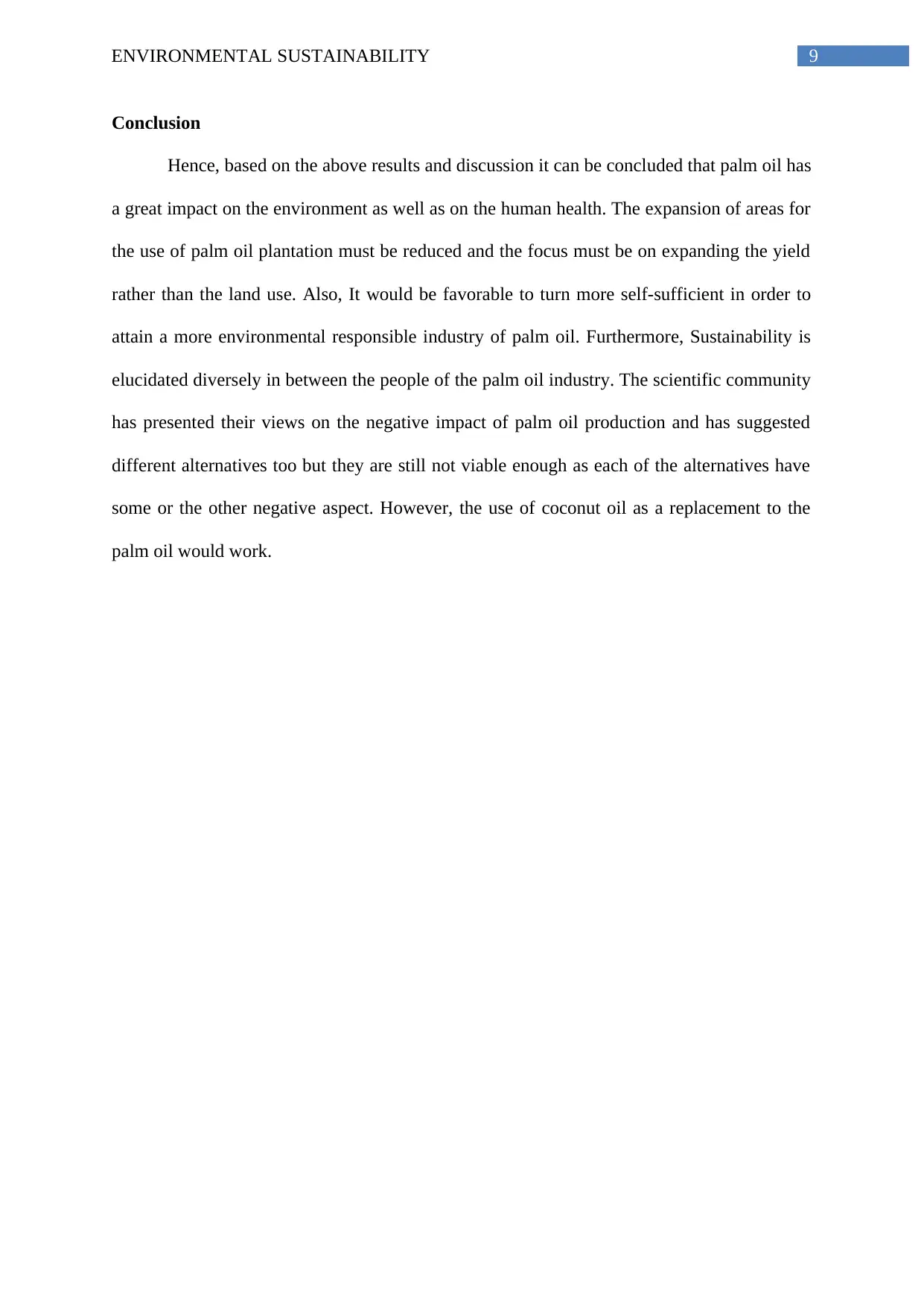
9ENVIRONMENTAL SUSTAINABILITY
Conclusion
Hence, based on the above results and discussion it can be concluded that palm oil has
a great impact on the environment as well as on the human health. The expansion of areas for
the use of palm oil plantation must be reduced and the focus must be on expanding the yield
rather than the land use. Also, It would be favorable to turn more self-sufficient in order to
attain a more environmental responsible industry of palm oil. Furthermore, Sustainability is
elucidated diversely in between the people of the palm oil industry. The scientific community
has presented their views on the negative impact of palm oil production and has suggested
different alternatives too but they are still not viable enough as each of the alternatives have
some or the other negative aspect. However, the use of coconut oil as a replacement to the
palm oil would work.
Conclusion
Hence, based on the above results and discussion it can be concluded that palm oil has
a great impact on the environment as well as on the human health. The expansion of areas for
the use of palm oil plantation must be reduced and the focus must be on expanding the yield
rather than the land use. Also, It would be favorable to turn more self-sufficient in order to
attain a more environmental responsible industry of palm oil. Furthermore, Sustainability is
elucidated diversely in between the people of the palm oil industry. The scientific community
has presented their views on the negative impact of palm oil production and has suggested
different alternatives too but they are still not viable enough as each of the alternatives have
some or the other negative aspect. However, the use of coconut oil as a replacement to the
palm oil would work.
Paraphrase This Document
Need a fresh take? Get an instant paraphrase of this document with our AI Paraphraser
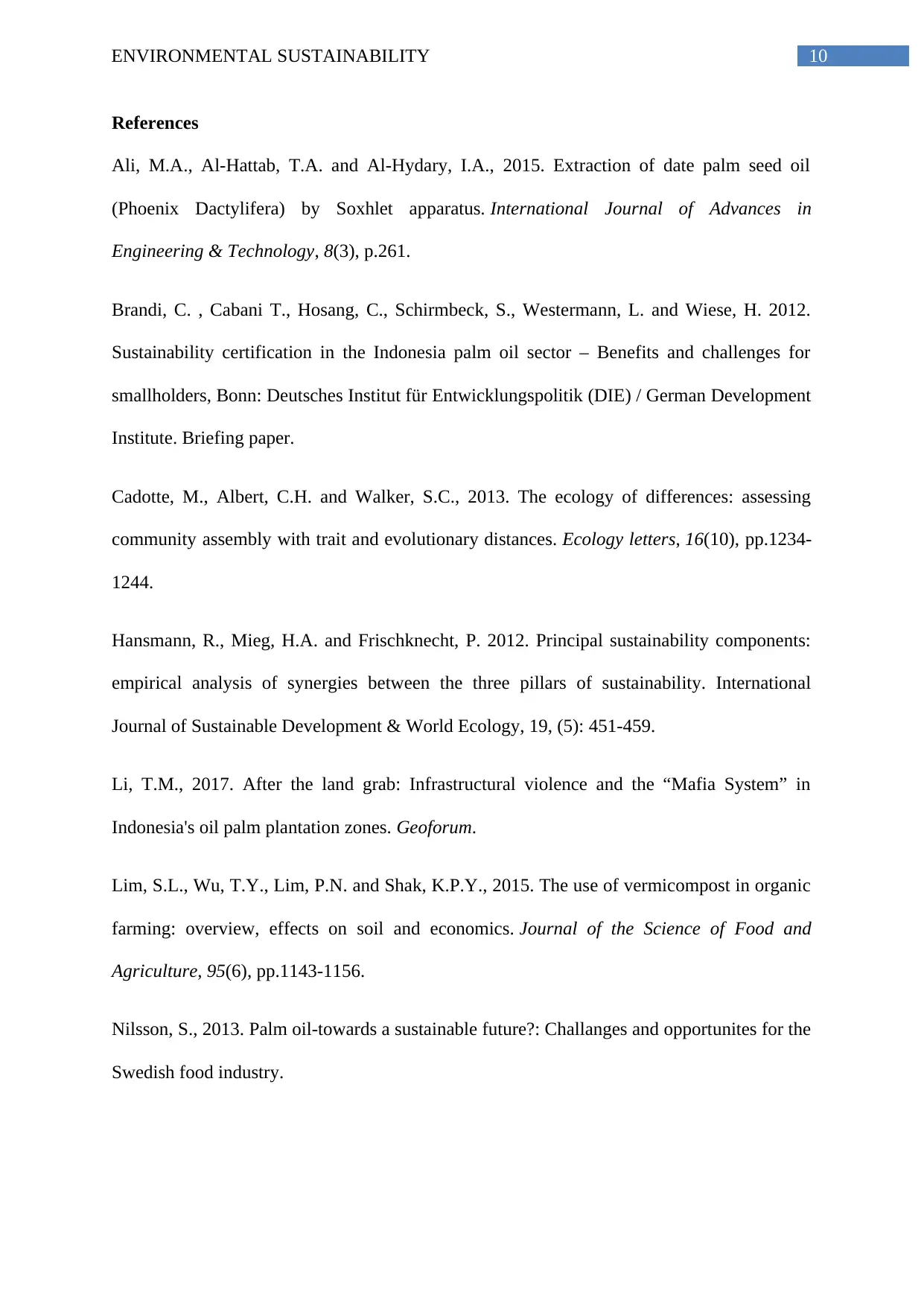
10ENVIRONMENTAL SUSTAINABILITY
References
Ali, M.A., Al-Hattab, T.A. and Al-Hydary, I.A., 2015. Extraction of date palm seed oil
(Phoenix Dactylifera) by Soxhlet apparatus. International Journal of Advances in
Engineering & Technology, 8(3), p.261.
Brandi, C. , Cabani T., Hosang, C., Schirmbeck, S., Westermann, L. and Wiese, H. 2012.
Sustainability certification in the Indonesia palm oil sector – Benefits and challenges for
smallholders, Bonn: Deutsches Institut für Entwicklungspolitik (DIE) / German Development
Institute. Briefing paper.
Cadotte, M., Albert, C.H. and Walker, S.C., 2013. The ecology of differences: assessing
community assembly with trait and evolutionary distances. Ecology letters, 16(10), pp.1234-
1244.
Hansmann, R., Mieg, H.A. and Frischknecht, P. 2012. Principal sustainability components:
empirical analysis of synergies between the three pillars of sustainability. International
Journal of Sustainable Development & World Ecology, 19, (5): 451-459.
Li, T.M., 2017. After the land grab: Infrastructural violence and the “Mafia System” in
Indonesia's oil palm plantation zones. Geoforum.
Lim, S.L., Wu, T.Y., Lim, P.N. and Shak, K.P.Y., 2015. The use of vermicompost in organic
farming: overview, effects on soil and economics. Journal of the Science of Food and
Agriculture, 95(6), pp.1143-1156.
Nilsson, S., 2013. Palm oil-towards a sustainable future?: Challanges and opportunites for the
Swedish food industry.
References
Ali, M.A., Al-Hattab, T.A. and Al-Hydary, I.A., 2015. Extraction of date palm seed oil
(Phoenix Dactylifera) by Soxhlet apparatus. International Journal of Advances in
Engineering & Technology, 8(3), p.261.
Brandi, C. , Cabani T., Hosang, C., Schirmbeck, S., Westermann, L. and Wiese, H. 2012.
Sustainability certification in the Indonesia palm oil sector – Benefits and challenges for
smallholders, Bonn: Deutsches Institut für Entwicklungspolitik (DIE) / German Development
Institute. Briefing paper.
Cadotte, M., Albert, C.H. and Walker, S.C., 2013. The ecology of differences: assessing
community assembly with trait and evolutionary distances. Ecology letters, 16(10), pp.1234-
1244.
Hansmann, R., Mieg, H.A. and Frischknecht, P. 2012. Principal sustainability components:
empirical analysis of synergies between the three pillars of sustainability. International
Journal of Sustainable Development & World Ecology, 19, (5): 451-459.
Li, T.M., 2017. After the land grab: Infrastructural violence and the “Mafia System” in
Indonesia's oil palm plantation zones. Geoforum.
Lim, S.L., Wu, T.Y., Lim, P.N. and Shak, K.P.Y., 2015. The use of vermicompost in organic
farming: overview, effects on soil and economics. Journal of the Science of Food and
Agriculture, 95(6), pp.1143-1156.
Nilsson, S., 2013. Palm oil-towards a sustainable future?: Challanges and opportunites for the
Swedish food industry.
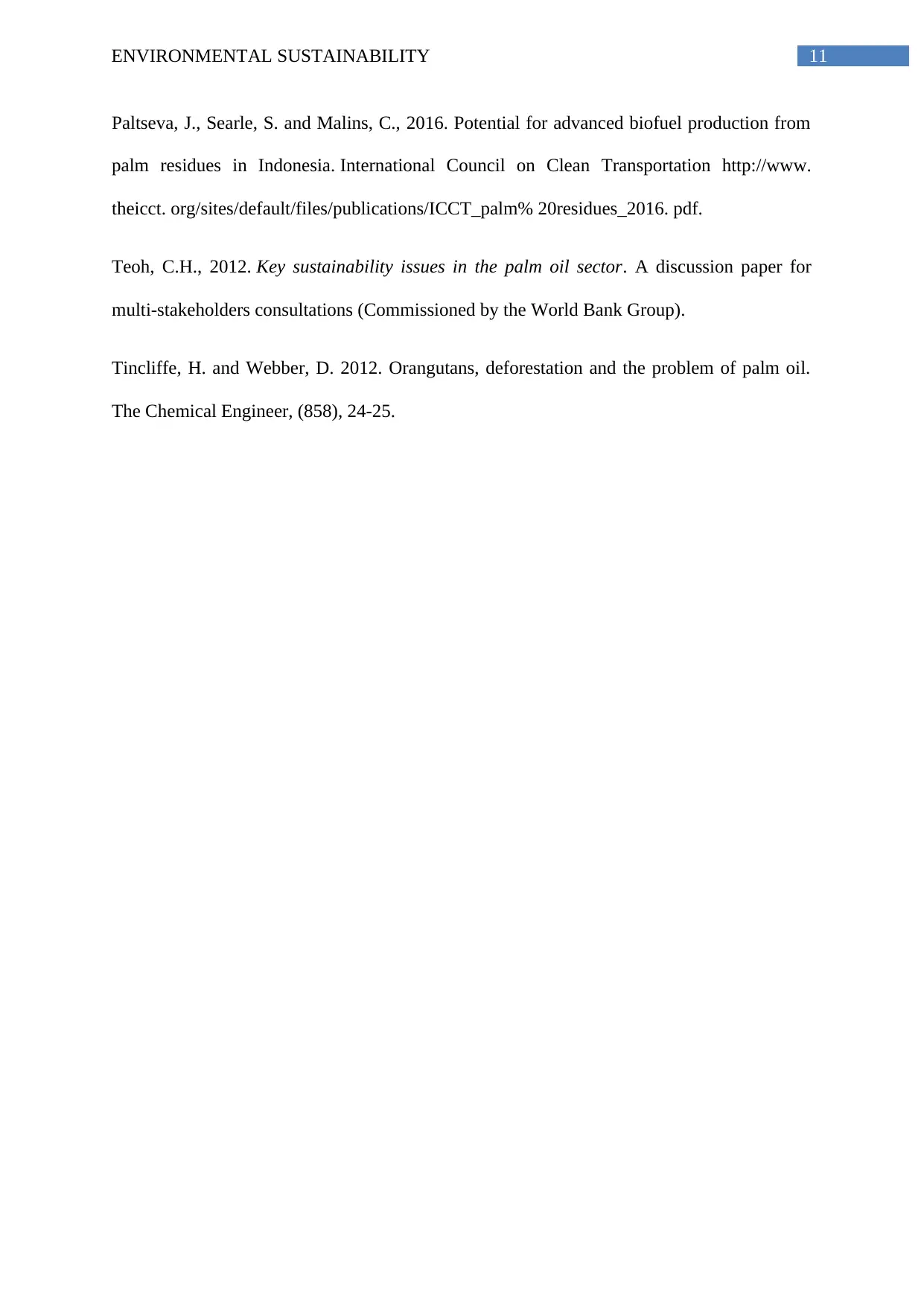
11ENVIRONMENTAL SUSTAINABILITY
Paltseva, J., Searle, S. and Malins, C., 2016. Potential for advanced biofuel production from
palm residues in Indonesia. International Council on Clean Transportation http://www.
theicct. org/sites/default/files/publications/ICCT_palm% 20residues_2016. pdf.
Teoh, C.H., 2012. Key sustainability issues in the palm oil sector. A discussion paper for
multi-stakeholders consultations (Commissioned by the World Bank Group).
Tincliffe, H. and Webber, D. 2012. Orangutans, deforestation and the problem of palm oil.
The Chemical Engineer, (858), 24-25.
Paltseva, J., Searle, S. and Malins, C., 2016. Potential for advanced biofuel production from
palm residues in Indonesia. International Council on Clean Transportation http://www.
theicct. org/sites/default/files/publications/ICCT_palm% 20residues_2016. pdf.
Teoh, C.H., 2012. Key sustainability issues in the palm oil sector. A discussion paper for
multi-stakeholders consultations (Commissioned by the World Bank Group).
Tincliffe, H. and Webber, D. 2012. Orangutans, deforestation and the problem of palm oil.
The Chemical Engineer, (858), 24-25.
⊘ This is a preview!⊘
Do you want full access?
Subscribe today to unlock all pages.

Trusted by 1+ million students worldwide
1 out of 12
Related Documents
Your All-in-One AI-Powered Toolkit for Academic Success.
+13062052269
info@desklib.com
Available 24*7 on WhatsApp / Email
![[object Object]](/_next/static/media/star-bottom.7253800d.svg)
Unlock your academic potential
Copyright © 2020–2025 A2Z Services. All Rights Reserved. Developed and managed by ZUCOL.





